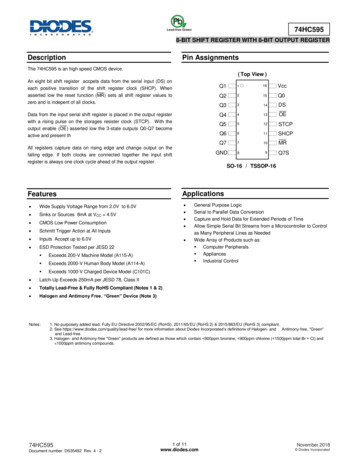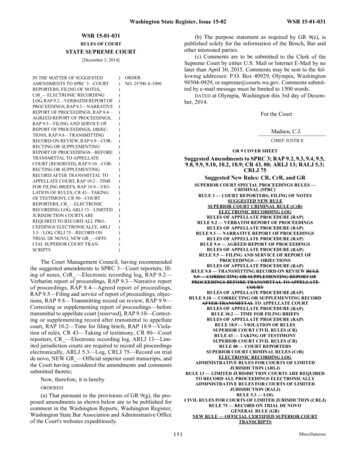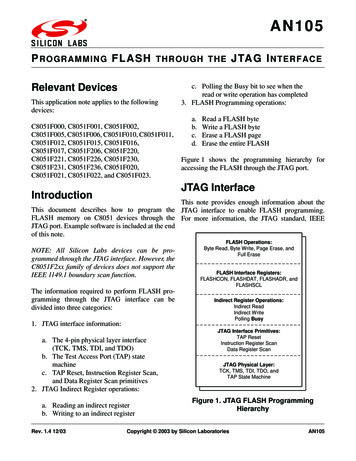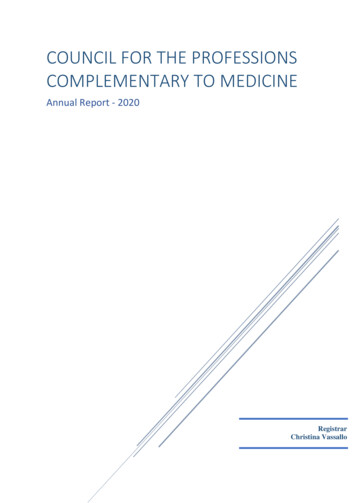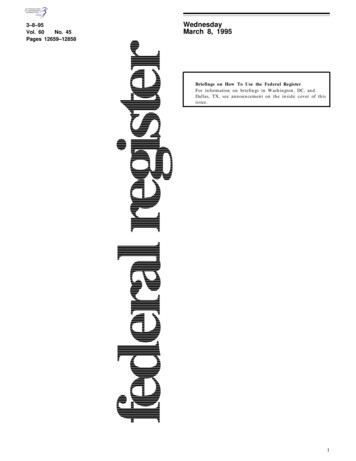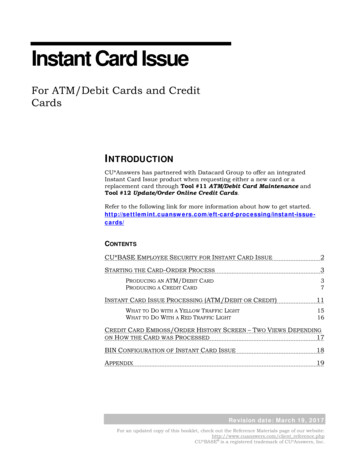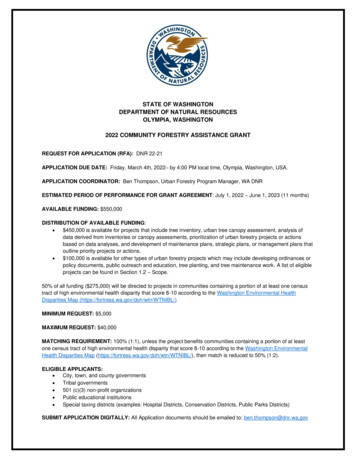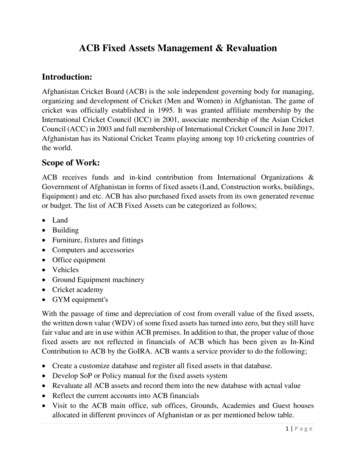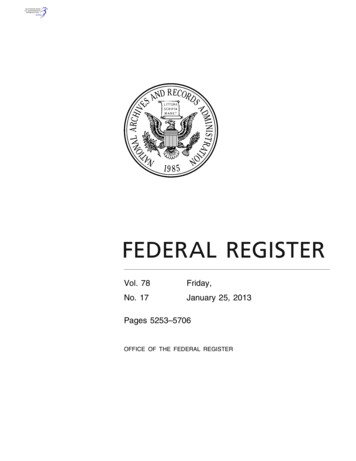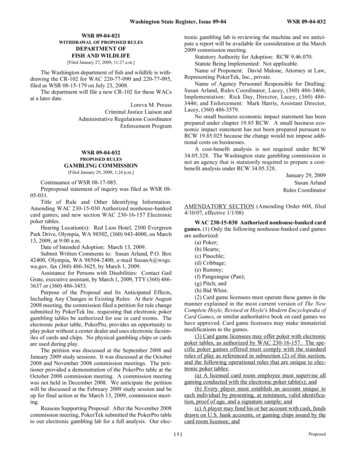
Transcription
Washington State Register, Issue 09-04WSR 09-04-021WSR 09-04-032tronic gambling lab is reviewing the machine and we anticipate a report will be available for consideration at the March2009 commission meeting.Statutory Authority for Adoption: RCW 9.46.070.Statute Being Implemented: Not applicable.Name of Proponent: David Malone, Attorney at Law,Representing PokerTek, Inc., private.Name of Agency Personnel Responsible for Drafting:Susan Arland, Rules Coordinator, Lacey, (360) 486-3466;Implementation: Rick Day, Director, Lacey, (360) 4863446; and Enforcement: Mark Harris, Assistant Director,Lacey, (360) 486-3579.No small business economic impact statement has beenprepared under chapter 19.85 RCW. A small business economic impact statement has not been prepared pursuant toRCW 19.85.025 because the change would not impose additional costs on businesses.A cost-benefit analysis is not required under RCW34.05.328. The Washington state gambling commission isnot an agency that is statutorily required to prepare a costbenefit analysis under RCW 34.05.328.January 29, 2009Susan ArlandRules CoordinatorWITHDRAWAL OF PROPOSED RULESDEPARTMENT OFFISH AND WILDLIFE[Filed January 27, 2009, 11:27 a.m.]The Washington department of fish and wildlife is withdrawing the CR-102 for WAC 220-77-090 and 220-77-095,filed as WSR 08-15-179 on July 23, 2008.The department will file a new CR-102 for these WACsat a later date.Loreva M. PreussCriminal Justice Liaison andAdministrative Regulations CoordinatorEnforcement ProgramWSR 09-04-032PROPOSED RULESGAMBLING COMMISSION[Filed January 29, 2009, 1:24 p.m.]Continuance of WSR 08-17-085.Preproposal statement of inquiry was filed as WSR 0805-031.Title of Rule and Other Identifying Information:Amending WAC 230-15-030 Authorized nonhouse-bankedcard games; and new section WAC 230-16-157 Electronicpoker tables.Hearing Location(s): Red Lion Hotel, 2300 EvergreenPark Drive, Olympia, WA 98502, (360) 943-4000, on March13, 2009, at 9:00 a.m.Date of Intended Adoption: March 13, 2009.Submit Written Comments to: Susan Arland, P.O. Box42400, Olympia, WA 98504-2400, e-mail SusanA@wsgc.wa.gov, fax (360) 486-3625, by March 1, 2009.Assistance for Persons with Disabilities: Contact GailGrate, executive assistant, by March 1, 2009, TTY (360) 4863637 or (360) 486-3453.Purpose of the Proposal and Its Anticipated Effects,Including Any Changes in Existing Rules: At their August2008 meeting, the commission filed a petition for rule changesubmitted by PokerTek Inc. requesting that electronic pokergambling tables be authorized for use in card rooms. Theelectronic poker table, PokerPro, provides an opportunity toplay poker without a center dealer and uses electronic facsimiles of cards and chips. No physical gambling chips or cardsare used during play.The petition was discussed at the September 2008 andJanuary 2009 study sessions. It was discussed at the October2008 and November 2008 commission meetings. The petitioner provided a demonstration of the PokerPro table at theOctober 2008 commission meeting. A commission meetingwas not held in December 2008. We anticipate the petitionwill be discussed at the February 2009 study session and beup for final action at the March 13, 2009, commission meeting.Reasons Supporting Proposal: After the November 2008commission meeting, PokerTek submitted the PokerPro tableto our electronic gambling lab for a full analysis. Our elec-AMENDATORY SECTION (Amending Order 608, filed4/10/07, effective 1/1/08)WAC 230-15-030 Authorized nonhouse-banked cardgames. (1) Only the following nonhouse-banked card gamesare authorized:(a) Poker;(b) Hearts;(c) Pinochle;(d) Cribbage;(e) Rummy;(f) Panguingue (Pan);(g) Pitch; and(h) Bid Whist.(2) Card game licensees must operate these games in themanner explained in the most current version of The NewComplete Hoyle, Revised or Hoyle's Modern Encyclopedia ofCard Games, or similar authoritative book on card games wehave approved. Card game licensees may make immaterialmodifications to the games.(3) Card game licensees may offer poker with electronicpoker tables, as authorized by WAC 230-16-157. The specific poker games offered must comply with the standardrules of play as referenced in subsection (2) of this section,and the following operational rules that are unique to electronic poker tables:(a) A licensed card room employee must supervise allgaming conducted with the electronic poker table(s); and(b) Every player must establish an account unique toeach individual by presenting, at minimum, valid identification, proof of age, and a signature sample; and(c) A player may fund his or her account with cash, fundsdrawn on U.S. bank accounts, or gaming chips issued by thecard room licensee; and[1]Proposed
WSR 09-04-049Washington State Register, Issue 09-04(d) A player or card room employee must transfer fundsfrom the player's account to a specified seat at a designatedelectronic poker table and activate play at the seat by use of anonvalue identification card unique to the player; and(e) Neither a player nor card room employee may insertcash or other instruments of value in the electronic pokertable; and(f) Players may purchase chips only at their assignedtable through funds accessible from their individual account;and(g) Fees may be assessed by time, per hand played, or byrake, and a licensed card room employee shall oversee thecollection of all fees and the deposit of said fees in the table'selectronic drop box; and(h) A minimum of two or more players is required beforea game can begin; and(i) All wagers must be made with chips issued by andused as part of the electronic poker table; and(j) Games offered on electronic poker tables must operate as center-dealt games; and(k) All poker games offered with electronic poker tablesmust meet all applicable surveillance requirements; and(l) If a player wins a player supported jackpot or otherprize of five hundred dollars or more while playing on anelectronic poker table, the winning combination of cardsmust be recorded by surveillance and an electronic or paperrecord of the card combination must be generated andretained in accordance with agency rules; and(m) To cash out, a player must conclude play at the table,remove his or her player account card, and present it withvalid photo identification to a licensed card room employeeat the cashier's cage; the card room employee must confirmthe player's identity and, if applicable, cause appropriatefinancial and/or tax reporting forms to be completed; and(n) Because the electronic poker tables operate with aself-contained accounting system, no count room proceduresare required; however, all fees collected by electronic pokertables will be recorded as part of the card room's daily recordsat least once every twenty-four hours.(g) May be operated only by card room personnel anddoes not allow players to play solely against the equipment;and(h) Allows testing of the computer software; and(i) Operates in accordance with approved internal controls specific to electronic poker tables.(2) Manufacturers must have a licensed gaming laboratory test and certify the system complies with subsection (1)of this section.(3) Manufacturers must also submit their system to us fortesting, as explained in WAC 230-06-050, with the certification from the independent laboratory and receive ourapproval before electronic poker tables may be offered forplay.WSR 09-04-049PROPOSED RULESSTATE BOARD OF HEALTH[Filed January 30, 2009, 12:33 p.m.]Continuance of WSR 08-15-174.Preproposal statement of inquiry was filed as WSR 0420-050.Title of Rule and Other Identifying Information: Chapter 246-366A WAC, Primary and secondary schools, thischapter provides minimum health and safety rules for allschools in Washington state. The original CR-102 is beingamended to provide notice of a new date of intended adoption.Date of Intended Adoption: March 11, 2009.Purpose of the Proposal and Its Anticipated Effects,Including Any Changes in Existing Rules: The state board ofhealth is filing a continuance to WSR 08-15-175 [08-15-174]to set a new adoption date. The purpose of the proposal is toupdate the current chapter 246-366 WAC to include provisions for water quality sampling, indoor air quality, andsafety in areas such as playgrounds, labs, and shops. The proposal repeals the former chapter 246-366 WAC and recodifies it into a new chapter 246-366A WAC. The entire newchapter is organized to provide clarity for those provisionsthat are construction related and those provisions that areoperation and maintenance related.Reasons Supporting Proposal: Students, parents, andteachers requested the state board of health udpate [update]and strengthen the primary and secondary school rules to better protect children's health and safety. The last major updateof the chapter was in 1971 and standards for health and safetyhave changed considerably since that time. Further, the rulesneeded to be rewritten to provide clarity.Statutory Authority for Adoption: RCW 43.20.050.Statute Being Implemented: RCW 43.20.050.Rule is not necessitated by federal law, federal or statecourt decision.Name of Proponent: State board of health, governmental.Name of Agency Personnel Responsible for Drafting:Ned Therien, Tumwater, Washington, (360) 236-4103;Implementation and Enforcement: Nancy Bernard, Tumwater, Washington, (360) 236-3072.NEW SECTIONWAC 230-16-157 Electronic poker tables. (1) Manufacturers of electronic poker tables must ensure their pokertable system:(a) Reproduces accurate facsimiles of a single, standarddeck of cards; and(b) Randomly shuffles cards before each round of play;and(c) Reproduces accurate facsimiles of chips, clearly evidencing chip color and value; and(d) Employs an accounting system or software to document the method of collection for game fees and, if applicable, player-supported jackpot funds and fees; and(e) Contains a backup system that records and displays atleast five previous rounds of play; and(f) Contains security protocol which prevents unauthorized access; andProposed[2]
Washington State Register, Issue 09-04 A small business economic impact statement has beenprepared under chapter 19.85 RCW.Small Business Economic Impact StatementBrief Description of the Rule: Approximately one million children attend schools in Washington state. The stateboard of health (the board) is required to establish rules forenvironmental health and safety in all schools and has doneso since the 1960s. The current framework in chapter 246366 WAC, Primary and secondary schools, has been in placesince 1971. These rules apply to two hundred ninety-fivepublic school districts with approximately two thousand threehundred school facilities as well as approximately four hundred fifty private schools. These rules are administered bylocal health jurisdictions.In 2004, the board directed the department of health (thedepartment) to begin a rule-making process in response togrowing concerns that the rules were generally outdated andno longer adequate for indoor air quality, drinking water, andsafety in areas such as laboratories and playgrounds. As aresult, this proposal will repeal the current chapter 246-366WAC and replace it with chapter 246-366A WAC that hasbeen reorganized and rewritten to clarify those requirementsthat are construction related and those that are a part of ongoing operation and maintenance of facilities. Many parts ofthe current chapter have been reorganized and rewritten forclarity, but have not changed significantly.The current rules, chapter 246-366 WAC, establishesminimum environmental health and safety standards forschools in Washington state. The specific objectives of theproposed revisions are to protect students and users of schoolfacilities from environmental hazards by: Delineating responsibilities of the school boards andofficials, the local board of health and health officer,and the department;School TypeElementaryMiddle/Jr. HighHigh SchoolSize of School(sq/ft)65,00095,000225,000Students perSchool4896881,442Start-up*O&MCosts per School 23,774 22,224 23,900WSR 09-04-049Improving indoor air quality;Improving playground safety;Improving water quality monitoring;Improving mold prevention and remediation; andImproving overall school safety.Small Business Economic Impact Statement Requirement: The department has reviewed this proposal and hasdetermined that a small business economic impact statementis required because these rules affect privately-ownedschools, which, for the purposes of this analysis, are considered businesses. Small public schools are not included in thisanalysis as they are not considered a business under the Regulatory Fairness Act, chapter 19.85 RCW.Industries Affected by the Rule: The industry affectedby these rules is privately owned schools.Costs of Complying with the Rule: The tables belowreflect the incremental construction costs and operation andmaintenance (O&M) costs for these rules. These costs areexpressed as costs per school and cost per student. Thesecosts are identified and explained in the preliminary significant analysis for these rules.The department assumes, with few exceptions such asplayground equipment standards and HVAC costs, thesecosts apply to a representative school regardless of ownershiptype, i.e., public or private.School TypeElementaryMiddle/Jr.HighHigh SchoolStart-up O&MCosts per Student 48.62 32.30 16.57Size ofRepresentativeSchool (sq/ft)65,00095,000IncrementalConstructionCosts perSchool 317,850 519,650IncrementalConstructionCosts perSquare Foot 4.89 5.47225,000 960,750 4.27Annual On-goingO&M Costs per School 9,042 7,239 8,481Annual On-going O&MCosts per Student 18.49 10.52 5.88*Start-up costs reflect the one-time costs for water quality, HVAC retrofit, and policy development although actual implementation dates for these requirementswill vary depending on the requirement and school type.Disproportionate Impact on Small Businesses: Thedepartment has determined that these rules may impose a disproportionate impact on small businesses. The departmentassumes that private schools are generally located in smallersized facilities with fewer students per school. Based oninformation from the Office of Superintendent of PublicInstruction's web site, the approximate five hundred privateschools serve on average one hundred fifty-four studentseach. Based on this fact and coupled with the reality of economies of scale, these privately-owned schools will incur ahigher average cost per square foot and per student to complywith these rules than larger public schools. Thus, using anyof the methods provided for in statute to gauge impact (costper employee (teachers and other school staff), cost per hourof labor (custodial staff), or cost per hundred dollars of sales(tuition)), these rules will have a disproportionate impact onprivately-owned schools.Mitigation Measures: The following describes mitigation measures considered during the development of theserules.Reduce, modify, or eliminate substantive regulatoryrequirements: These rules do not propose to reduce, modify, or eliminate substantive regulatory requirements forsmall businesses, to do so would create dual standards that, ineffect, would provide different health and safety protectionfor students based on school size or school ownership type.Simplify, reduce, or eliminate record-keeping andreporting requirements: These rules identify minimumrecord-keeping and reporting requirements necessary toachieve the intent of these rules.Reduce the frequency of inspections: These rulesestablish consistent inspection frequency for all schoolsregardless of size or ownership type. However, the proposalgrants local health jurisdictions the discretion to allow[3]Proposed
WSR 09-04-049Washington State Register, Issue 09-04obtained by contacting Vicki Bouvier, P.O. Box 47820,Olympia, WA 98504-7820, phone (360) 236-3011, fax (360)236-2250, e-mail vicki.bouvier@doh.wa.gov.Craig McLaughlinExecutive Directorschools to self-inspect two out of every three years as a wayto reduce costs.Delay compliance timetables: O&M - Two components of these rules have delayed implementation dates. Thechange from annual to periodic inspections is delayed oneyear from the effective date of these rules. Water qualitymonitoring for lead and copper have staggered effective datesstarting with elementary schools in the first two years, juniorhigh schools the third year, and senior high schools the fourthyear.Construction - There are conditions that modify theapplicability of certain construction requirements of thischapter. The first in WAC 246-366A-005 provides for application of the existing construction requirements of chapter246-366 WAC if the local permitting jurisdiction received acomplete building permit application for school constructionprior to September 1, 2010. The site review requirements ofWAC 246-366A-030 allow for the same deviation from construction-related requirements if construction plan notification to the local health officer is made prior to September 1,2010. WAC 246-366A-090 provides deviation from the newheating and ventilation construction requirements related toducted air returns and upgraded duct lining if the local permitting jurisdiction received a complete building permitapplication prior to September 1, 2013.Reduce or modify fine schedules for noncompliance:This mitigation measure is not possible to apply to this rulemaking as there are no fine schedules established in theserules.Other mitigation techniques: The department will provide privately-owned schools with all model policies (e.g.,approved use and management of hazardous materials, use ofupholstered furniture, animals in schools, safety standards,etc.) to help schools comply with these rules with the lowestpossible cost.These rules allow for variance requests to the localhealth officer so that schools can meet the intent of theserules in alternative, less costly ways.Small Business Involvement in Rule Development: Thedepartment invited private school representatives to serve onthe original school rule development committee as well as thecosting workshop and the later rule revision team. Proposalsfrom the representatives of private schools were consideredas part of the process of rule development, but did not includeproposed rule changes to specifically accommodate the special needs of private schools.Jobs Created or Lost as a Result of the Rule: The department assumes that private schools will meet the intent ofthese rules in the least costly manner, which could includeapproved variances through the local health officer. Thedepartment assumes that any additional costs incurred by private schools will be passed on to parents via increased tuitionrates. Therefore, the department and the board conclude thatthese rules will not result in any jobs created or lost.A copy of the statement may be obtained by contactingVicki Bouvier, P.O. Box 47820, Olympia, WA 98504-7820,phone (360) 236-3011, fax (360) 236-2250, e-mail vicki.bouvier@doh.wa.gov.A cost-benefit analysis is required under RCW34.05.328. A preliminary cost-benefit analysis may beProposedChapter 246-366A WACPRIMARY AND SECONDARY SCHOOLSNEW SECTIONWAC 246-366A-001 Introduction and purpose.These rules establish minimum environmental health andsafety standards for school facilities and are intended to promote a healthy and safe school environment.NEW SECTIONWAC 246-366A-005 Applicability. (1) These rulesapply to all school facilities operated for the primary purposeof providing education at the kindergarten through twelfthgrade (K-12) levels, and preschools that are part of such facilities except:(a) Private residences used for home-based instruction asdefined by RCW 28A.225.010(4);(b) Facilities hosting educational programs where educational instruction is not a primary purpose, including, but notlimited to, detention centers, jails, hospitals, mental healthunits, or long-term care facilities;(c) Private facilities where tutoring is the primary purpose; and(d) Public or private postsecondary education facilitiesproviding instruction to students primarily enrolled in secondary school.(2) These rules are in addition to all other requirementsthat apply to schools and do not affect the applicability ofthose requirements.(3) Additional state board of health environmental healthand safety rules that apply to school facilities include, but arenot limited to:(a) Chapter 246-215 WAC Food services;(b) Chapter 246-217 WAC Food worker cards;(c) Chapter 246-260 WAC Water recreation facilities;(d) Chapter 246-262 WAC Recreational water contactfacilities;(e) Chapter 246-272A WAC On-site sewage systems;(f) Chapter 246-272B WAC Large on-site sewage system regulations;(g) Chapter 246-290 WAC Public water supplies; and(h) Chapter 246-291 WAC Group B public water systems.(4) These rules are not intended to replace or supersedethe department of labor and industries' authority and jurisdiction over employee safety and health.(5) For a school undergoing an alteration or addition,WAC 246-366A-040, 246-366A-060, 246-366A-090, 246366A-100, 246-366A-110, 246-366A-120, 246-366A-150,and 246-366A-160 apply only to:(a) Areas that are part of the addition;[4]
Washington State Register, Issue 09-04(b) Areas undergoing alteration; and(c) Changes to existing building systems, such as heatingand ventilation systems, when those changes are included inconstruction documents or a building permit applicationdescribing the alteration or addition.(6) If the local permitting jurisdiction received a complete building permit application for school constructionprior to September 1, 2010, the construction-related requirements of chapter 246-366 WAC in effect at the time of application apply.WSR 09-04-049(c) Delivers at least 0.4 gallons (1.5 liters) of water perminute for at least fifteen minutes.(12) "Emergency shower" means a hand-activatedshower that delivers tepid potable water to cascade over theuser's entire body at a minimum rate of 20 gallons (75 liters)per minute for at least fifteen minutes.(13) "Equivalent sound level (Leq)" means the level of aconstant sound that, over a given time period, contains thesame amount of sound energy as the measured fluctuatingsound.(14) "Faucet" means the type of plumbing fixture that isa valved outlet device attached to a pipe that normally servesa sink or tub and can discharge both hot and cold water.(15) "First draw sample" means a water sample collectedimmediately upon opening a plumbing fixture that has notbeen used for at least eight hours prior to collection.(16) "Flush sample" means a water sample collectedafter allowing cold water to run for at least thirty secondsfrom a plumbing fixture that has not been used for at leasteight hours prior to collection.(17) "Foot-candle" means a unit of measure of the intensity of light falling on a surface, equal to one lumen persquare foot.(18) "Hazardous materials" means toxic, corrosive,flammable, explosive, persistent, or chemically reactive substances that, depending on dose and circumstances, pose athreat to human health.(19) "Imminent health hazard" means a significant threator significant danger to health or safety that requires immediate action to prevent serious illness, injury, or death.(20) "Laboratory" means instructional areas of theschool facility where students might be exposed to greaterpotential health and safety hazards than typically exist in general academic classrooms. Laboratories include, but are notlimited to, science laboratories (for example: Chemistry,physics, material science, and biology) and art laboratories(for example: Print-making, photography, and ceramics).(21) "Local board of health" means the county or districtboard of health as defined in RCW 70.05.010(3).(22) "Local health officer" means the legally qualifiedphysician who has been appointed as the health officer for thecounty or district public health department as defined inRCW 70.05.010, or his or her authorized representative,including, but not limited to, the environmental health director.(23) "Mechanical exhaust ventilation" means theremoval of indoor air to the outside of the building bymechanical means.(24) "Noise criterion (NC)" means a system for ratingthe noise level in an occupied area by comparing actual orcalculated sound level spectra with a series of establishedoctave band spectra.(25) "Noise criterion 35 (NC35)" means the curve forspecifying the maximum permissible sound pressure level foreach frequency band.(26) "Preschool" means an instructional curriculum andportion of a school facility designed to instruct children notold enough to attend kindergarten.NEW SECTIONWAC 246-366A-010 Definitions. The following definitions apply to these rules:(1) "Addition" means an extension or increase in floorarea or height of a building or structure.(2) "Air contaminants of public health importance"means pollutants in the indoor air that could, depending ondose and circumstances, have health impacts, including butnot limited to:(a) Volatile organic compounds, for example, formaldehyde and benzene;(b) Combustion by-products, for example, carbon monoxide and nitrogen oxides;(c) Vapors and gases, for example, chlorine, mercury,and ozone;(d) Heavy metal dusts and fumes, for example, chromium and lead; and(e) Particulates, for example, wood and ceramic dust.(3) "Alteration" means any construction or renovation toan existing structure other than repair or addition.(4) "Construction" or "construction project" means anyactivity subject to state or local building codes.(5) "Construction documents" means written, graphic,and pictorial documents prepared or assembled for describingthe design, location, and physical characteristics of the elements of a project necessary for obtaining a building permit.(6) "Contaminant" means any hazardous material thatoccurs at greater than natural background levels.(7) "Decibel (dB)" means a standard unit of measurement of sound pressure.(8) "Decibel, A-weighted (dBA)" means a decibel measure that has been weighted in accordance with the A-weighting scale. The A-weighting adjusts sound level as a functionof frequency to correspond approximately to the sensitivityof human hearing.(9) "Department" means the Washington state department of health.(10) "Drinking fountain" means the type of plumbingfixture that delivers a stream of water for drinking withoutactively cooling the water.(11) "Emergency eye wash" means a hands-free devicethat:(a) Irrigates and flushes both eyes simultaneously withtepid potable water;(b) Activates an on-off valve in one second or less andremains on without user assistance until intentionally turnedoff; and[5]Proposed
WSR 09-04-049Washington State Register, Issue 09-04(27) "Portable" means any relocatable structure that istransported to a school site and is placed or assembled therefor use by students as part of a school facility.(28) "Repair" means the reconstruction or renewal of anypart of an existing school facility for the purpose of its maintenance.(29) "School" means any public, religious-affiliated, orprivate institution for instructing students in any grade fromkindergarten through twelfth grade.(30) "School board" means an appointed or elected boardwhose primary responsibility is to operate schools or to contract for school services and includes the governing body orowner of a private school.(31) "School facility" means school-owned or leasedbuildings and grounds intended for student use including, butnot limited to, portables, playgrounds and sports fields.(32) "School officials" means those persons designatedby the school board as responsible for planning, policy development, budgeting, management, or other administrativefunctions.(33) "Shop" means instructional areas of the school facility where students are exposed to greater health and safetyhazards than typically exist in general academic classrooms.Shops include, but are not limited to, industrial and agricultural shops, including career and technical education (forexample: Metal-working, wood-working, construction, automotive, and horticulture).(34) "Site" means any real property used or proposed tobe used as a location for a school.(35) "Source capture system" means a mechanicalexhaust system designed and constructed to capture air contaminants at their source and release air contaminants to theoutdoor atmosphere.(36) "Tempered water" means water having a temperature range between eighty-five degrees Fahrenheit and onehundred ten degrees Fahrenheit.(37) "Tepid water" means water having a temperaturerange between sixty degrees Fahrenheit and ninety-fivedegrees Fahrenheit.(38) "Toxic" means having the properties to cause or significantly contribute to death, injury, or illness.(39) "Variance" means an alternative to a specificrequirement in these rules, approved by the local healthofficer, that provides a comparable level of protection.(40) "Very low lead plumbing fixture" means plumbingfittings or fixtures used in the installation or repair of anyplumbing providing water for human consumption that contain less than 0.3% lead by weight.(41) "Water cooler" means the type of plumbing fixturethat is a mechanical device affixed to drinking water supplyplumbing that actively cools the water.(b) Make the guide available on the department's website.(2) The guide is the primary source of guidance for localhealth officers and school officials implementing these rules.NEW SECTIONWAC 246-366A-020 Responsibilities—General. (1)Responsibilities of school officials. School officials shall:(a) Maintain conditions within the school environmentthat will not endanger health and safety.(b) Identify, assess, and mitigate or correct environmental health and safety hazards in their school facilities, establish necessary protective procedures, use appropriate controls, and take action to protect or separate those at risk fromidentified hazards, consistent with the level of risk presentedby the specific hazard, unti
modifications to the games. (3) Card game licensees may offer poker with electronic poker tables, as authorized by WAC 230-16-157. The spe-cific poker games offered must comply with the standard rules of play as referenced in subsection (2) of this section, and the following operational rules that are unique to elec-tronic poker tables:
